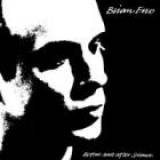NamCompendium 14: Xevious
By jeffrud 0 Comments
Xevious
December 1982 (Arcade, Japan)
1982 was a banner year for Namco, and I've endeavored to make the case that it represented the close of a golden age for the company. What better way to put a capstone on that year, than release one more barn burner? Xevious is quite the colossus, and has a rich history of ports (and port-adjacent things). Let's get right down into it.
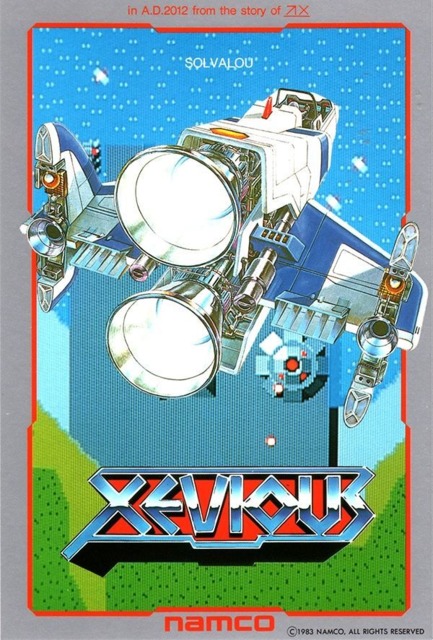
It is tempting to rush headlong and claim that Xevious is the first vertical scrolling shoot 'em up. But is that really the case? What distinguishes Xevious from a game like, for instance, Galaxian? That title a steady parallax simulation of a star field in the background, creating the sense of forward movement through space while fighting a hoard of enemies. Indeed, what distinguishes a game like Xevious from Space Invaders?
Beyond the fairly important quibble of fixed horizontal movement at the bottom of a screen, there are several taxonomical considerations at play here. Thankfully, being an academic employee who defers to expert opinions, I can fall back on the research of Dr. Jim Whitehead of UC Santa Cruz to clarify this subject. Whitehead does make the case that Space Invaders is indeed the first shmup, and that the themes of Taito's breakout hit (a lone hero avatar set in an abstract, decontextualized battle with inherent xenophobic overtones) have remained at the core of the genre since 1978. His own research has it that Xevious was predated as a vertical scrolling shooter by Mission-X, Zoar (both by Data East), and Funky Bee (by Orca), which makes Xevious merely the first vertical shooter that anybody remembers at all.
(Special thanks to Dr. Whitehead for sharing slides of his research)
While the credits list for Xevious is another nightmare to assemble, there is one name to which the title shall be forever bound: Masanobu Endou, making his premiere here on the NamCompendium. Endou is credited with programming Xevious, but it is primarily his design vision that has his name so tightly bound to the game. His vision was wildly ambitious compared to what had been previously attempted in the young shoot em up genre. Endou wanted a world with a sense of mystery, both through the fiction and theming of the game as well as the mechanics. He followed a principe that would later be utilized in the Dungeon World tabletop roleplaying game, namely "Name every NPC." Every enemy in Xevious has some lunatic name and factors into an elaborate fiction concocted by Endou himself. It was this commitment to a fiction that probably lead to him personally designing and drawing the enemies for the game as well as handling programming.

Endou's strange mix of futuristic space craft, combining traditional sprite work and fully pre-rendered sprites (a NamCompendium First!), set over an earth-like landscape decked in Nazca lines, all blend to create something alien and utterly unique. Add in a few invisible towers to bomb (denoted by the cursor changing from blue to red while passing over them) and you get some dubious mystery content as well. That Xevious would launch an entire line of sequels and spinoff games was unknowable at the time, but even without that foreknowledge it is still a fairly evocative game to play.
Without really getting into details, it is incredible that this fictional setting has never intersected with Namco's retroactively assembled UGSF fiction. I've been waiting to talk about UGSF, seeing as we've already covered a handful of games therein. I think I know where to put it in this series, and you'll want to stay tuned for that entry because I love everything about it.
Oh, and another NamCompendium First: this was the company's first game to feature a boss fight. Andor Genesis is a real rotten bastard and I'd be lying if I said I've ever actually beaten the damn thing. Go ahead and confiscate my gamer card.
The music here also warrants discussion, despite my intense distaste of said. This is another Yuriko Keino joint, hot off the heals from her more understated work on Pac & Pal. While I will give her full marks for her strident, Star Wars-esque fanfare to commence proceedings, the actual background music of Xevious is basically a shrill four second loop of arpeggiated treble blips with an eight step steady downward syncopated bass walk. Over. And over. And over again. If I am entirely honest, I think a lot of my own complicated feelings toward Xevious stem from the music. Yet it is clear that this loop resonated with people. No less than Haruomi Hosono, noted Japanese experimental musician, released an electronic album in 1984 titled Video Game Music. The man responsible for Hosono House, one of the members of Yellow Magic Orchestra, lead off an album of Namco remixes with a treatment of the Xevious music. It's true!
It should probably go without saying that Xevious was a success at home, and performed well in the United States upon its arrival in February 1983 (distribution by Bally-Midway). As came naturally for previous titles, there was a demand for home versions of this hit arcade shooter. And so, let us consider the ports.
The first of these is mostly a curiosity: an unfinished prototype of Xevious for the Atari 2600. Yes, I suppose I was slightly dishonest when I said we were done with the VCS in the last issue. It is not difficult to imagine why a port to Atari's 1977 home console was ruled out by company management: beyond the unfortunate timing—this appears to have been last worked upon in January 1984, the nadir of the North American home console market—this is also a desperate port. It's not so much that the game itself is bad, but rather that the platform and input device are entirely ill suited to a game like Xevious. Yes, the console did play home to other shoot 'em up games like River Raid, but you could play that with a single button. Xevious requires two buttons, and the solution here is to trigger a bomb drop with every button press to fire from the Solvalou. It's not great, but you have to admire the ambition of cramming an arcade game that ran on three Z80s clocked around 3MHz, to a single MOS 6502 that ran at around 1 megahertz. Atari actually announced that Xevious would come to the VCS at the Consumer Electronics Show in 1984, but ultimately shitcanned this port not long thereafter.
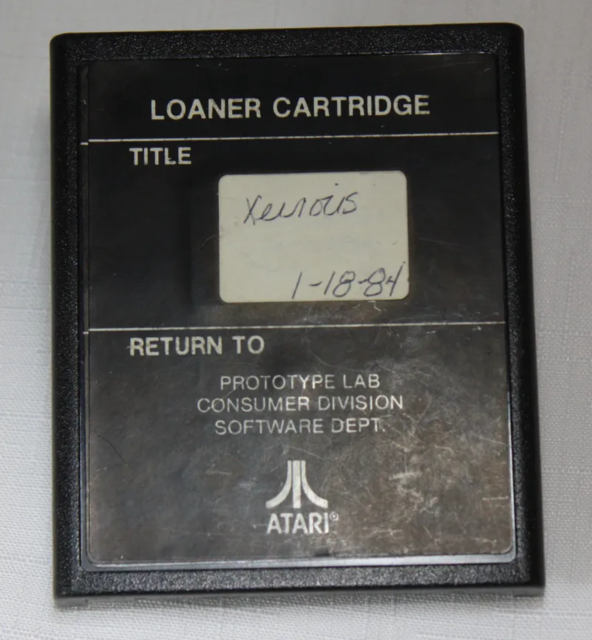
The primary point of curiosity here is that said developer was purportedly no other than Tod Frye, he who was whipped by Atari bosses into producing a port of Pac-Man for the aging system with inadequate resources as his third commercial product. AtariProtos.com, a site which deals in these sorts of unreleased games, has it that Frye was pulled off of SwordQuest: Airworld to put this port together. When you consider the sort of games the 2600 was meant to play, one would hopefully be inclined to give Frye a great deal of credit for producing ports that even resembled what at the time were cutting edge arcade titles. And it's all made even more impressive if you subscribe to the apocryphal note at Arcade-History.com, which states that Frye wrote a portion of the games code "under the influence of drugs".
As has been mentioned, the 7800's soft test launch in the United States occurred in mid-1984. Atari was in its "we are becoming two separate companies and this whole thing is a nightmare" phase, and Atari Incorporated were hemorrhaging money rapidly. New company management sought to realign the company's efforts toward supporting upcoming product lines rather than pouring money into moribund existing platforms, hence the ultimate axing this 2600 port. It was in this very same spirit that they also axed a 5200 port of Xevious.
Announced at Summer CES in June 1983, the 5200/Atari 8-bit computer port of Xevious had been the charge of Jim Huether (programming) and Alan Murphy (graphics). This is a more sophisticated game mechanically than what would have been made possible on the 2600, but it shares the dreadful sound and color palette of previously examined Namco ports on this family of systems. We do at least have a rendition of Keino's arcade music, as well as the thrill of two entire buttons to separate forward firing and bombing functions. It would have been a passable game for a platform positively starved for titles throughout its commercial life
For those of you wondering if Atari actually managed to squeeze out a single version of Xevious for any of its home consoles, you're in luck! The finally managed this feat of strength with the renowned 7800 conversion.
I actually went through the trouble of digging through recovered source code for this particular game to discover anything meaningful. It seems like work on 7800 Xevious had begun as early as July 1983. I'd give somebody named Stephen Keith an unspecified credit for his work on the title alongside somebody with the initials "NA". Keith, working for GCC on behalf of Atari, had originally been tasked with the 2600 conversion of Xevious before it that was handed to good old Tom Frye.

So, there are some who say this is the best 8-bit conversion of Xevious. I wouldn't go that far, but as 7800 games go this is one of the best on the entire system. The screen real estate is a bit cramped, but the pace of the game is slowed enough to prevent instances of off-screen bullshit merking you. My feelings on the music aside, they do a damn fine job replicating it here. While not utilizing pre-rendered sprites, the developers manage a simulacrum of the effect by cycling animations on the bacura enemies to simulate their constant rolling. Andor Genesis is also a little less fraught here, probably owing to a hard limit on sprites preventing the game from throwing as many shots at the player. In short, this was a fantastic 7800 launch title and its aficionados should not be brushed off so quickly when they tell you it's better than what NES owners got.
I'd like to make an aside here and talk about my reckoning of 7800 release dates. Those inclined to dig around on the Internet will note my dates are two years earlier than those conventionally used. It is practically true that the console released in 1986 for the overwhelming majority of people who purchased one during its natural life. I do not intend to a launch a grand crusade to alter years of accepted thinking (and hundreds of online sources) that place launch dates in 1986 or later for games in the 7800 library. I barely have time for this small website as it is. However, it is nevertheless true that a) the console did receive a test launch in mid-1984 in one corner of the United States, b) the console and every game available at this test launch were the creations of one second party company, General Computer Corporation, c) all five Namco licensed games for the 7800 were available day and date with this test launch, and d) people take the test launch of date of the NES to be the canonical launch date for North American titles like Super Mario Bros. I therefore see no reason whatsoever why it should not be said that Xevious and the four other Namco games on the system were 1984 games in a strict, literal sense. There is simply the enormous proviso that these games and their platform were then disappeared for two years while Atari dissolved and entered into protracted legal disputes over who owed whom what money for which work, as was the Atari way. Still, Xevious for the 7800 predated the Famicom port by five months and that's my position.
Speaking of which, here's Namco's third Nintendo game ever.
The first of these ports to have been developed internally at Namco, Xevious was the first "shmup" on the Famicom by the commonly accepted definition. It is also their most sophisticated game on the platform by a fair measure. The amount of moving objects on the screen is paired back, and enemy speed is dramatically reduced from the original arcade version. The scrolling background layer is also using a lower quality asset compared to the source. You also lose the pre-rendered sprites in this version, which should come as no surprise. Finally, the unique level count is trimmed from 16 to ten. Even with this changes, this is an incredibly refined title for the company's third outing on Nintendo's home console. The small development crew that handled this port managed to capture even some the smaller features of the arcade experience: the sound and music are very damn close, bombing for hidden Sol Towers still works as you recall, and even small touches like the smoldering terrain inside bomb craters is present. As good as the 7800 port is, this is absolutely my choice for best 8-bit home console port.
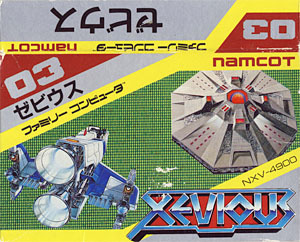
The nation of Japan agreed. On Wikipedia's combined list of best selling Famicom and NES titles, Xevious is the only Namco title to make the list without having "Family Stadium" in the name; in fact, it was narrowly outsold by Famista '87. 1.26 million copies of Xevious were purportedly sold in Japan. That's good enough to have Xevious as the 52nd best selling FC/NES game of all time. Now, I'm going to put about three pounds of salt on this claim as it cites one (dated) chart from an external website that does not reveal any sources, and it does not seem to included information on its subsequent re-releases. Still, that puts it ahead of celebrated titles like Mega Man 3, Gradius, and even Donkey Kong, the first and oldest title on the platform.
This is the second game we've encountered that was distributed in the west by Bandai. Xevious arrived on American store shelves in September 1988, just a month before Namco and their partners at Tengen launched their ill-fated unlicensed NES game gambit with Pac-Man. Fortunately, Xevious was spared such a fate and spent its natural life being distributed in a nice gray cartridge with a fun new subtitle: The Avenger. Bandai would release Xevious in PAL territories on 29 October 1989, and less than a year later Xevious received a Japan-exclusive Famicom Disk System reissue. Though I am assuming these FDS releases were all done as a cheap way to redistribute their own back catalog of FC titles, as a sort of precursor to the company's later efforts with the Namco Museum series, I continue to wonder if there is a more complicated back story to these re-releases. They occurred in the same window of time that Namco was seriously flirting with Nintendo's domestic console rivals Hudson/NEC and Sega, though even by 1990 those efforts were beginning to tail off and the company would publish games on the Famicom through 1993.
In any case, the FDS release was not the end for Famicom Xevious. Nintendo and Namco would pull this game out from mothballs in 2004 when it was included in the Famicom Mini line of FC/NES reissues for the Game Boy Advance. First arriving in Japan in February, the GBA port of the FC port of Xevious would make its way to North American and Europe in June and July of the same year, respectively. This is the only copy of Xevious I own! I bought it while I was in Okinawa, for somewhere in the 500 yen range. Like all entries in this series of reissues, the game suffers from having to be stretched and squished a bit to fit on a GBA display. It was also criticized at the time for its $20 asking price, a gripe that was leveled at basically every single one of these titles. I'd say $5 is a reasonable price for what is admittedly a slight experience these days, and the Japanese versions of these games all had nice Famicom colored cartridges that make them stand out from the crowd.
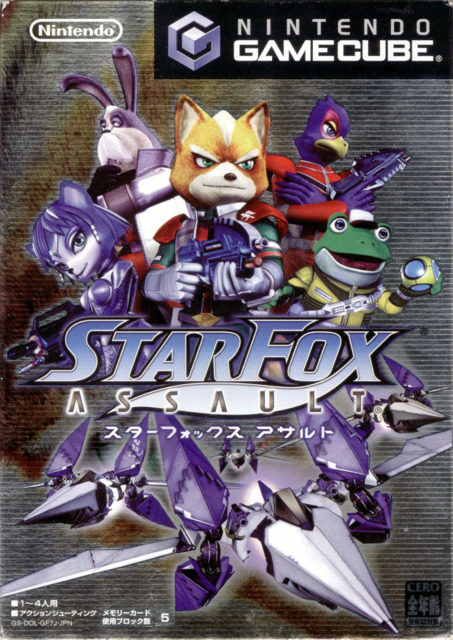
By the way, did you know there are two different ways to play Famicom Xevious on your Gamecube? It's true! You could go the Game Boy Player route with the GBA cart, or you could be decidedly cooler. In the midst of our ongoing "Star Fox is not an A-tier Nintendo property and basically nobody in the company cares about the franchise" milieu, Nintendo licensed out the Star Fox property to Namco for the follow to the also-licensed Star Fox Adventure on the Gamecube. The result was Star Fox Assault, a mixed package of rail shooting and third person action...stuff...that will be covered around 2045 on this website. Why bring up Star Fox Assault? Included in this package is an unlockable Famicom Xevious, awarded for obtaining all silver medals in the game's campaign mode. What's even more buck wild is that this isn't the only one of Namco's Famicom titles playable off native Gamecube hardware, but we'll come back to that topic in a few entries.
But wait, there's more! Famicom Xevious had the distinct honor of being part of the first wave of Virtual Console games in Japan! Being the only (then) Bandai Namco title included in this inaugural push, Xevious joined Gradius and Solomon's Key as one of three third party Famicom to help kick off Nintendo's first digital console store front on 2 December 2006. It was also the first Namco game on the North American and European Virtual Consoles, arriving 12 and 15 January 2007. This same port then came to the 3DS VC, exclusively in Japan, on 7 June 2011. Most recently it was made available on the Japanese and NA/EU Wii U Virtual Console shops respectively on 27 April and 9 May 2013.
So across platforms and regions, Famicom Xevious has had 14 separate releases on five different hardware platforms (six if you count the Famicom Disk System as its own thing). That, dear readers, is some goddamn legs.
I will here briefly touch upon a fun edge case that I almost included in this article but have ultimately decided to treat as its own thing—Xevious: Fardraut Saga. Released in two similar but slightly different packages for the MSX2 (1988), and PC Engine (1990), Xevious: Fardraut Saga contains two separate games, one of which is a pretty faithful recreation of arcade Xevious. The other, titled Fardraut on the PC Engine in-game menu, is a sort of retelling/sequel thing to Xevious proper. One which, for the record, should not be conflated with the sort of kind of basically sequel that is Super Xevious. These titles will be treated with their own pieces later, but suffice it to say that you could play Xevious on the PC Engine and it's pretty good.
We now come to the archival stage of Xevious, which has survived to the present day through the wonders of digital distribution. The title was rolled up into Namco Museum Volume 2 for Sony PlayStation in 1996, joining Mappy and Cutie Q (or Super Pac-Man for those stuck with the NTSC/PAL release). While it would have been more of an honorific to include it in the first volume alongside Pac-Man and Galaga, Namco were attempting to stretch this series out over six releases and had to load each issue with one or two crowd pleasers. Xevious was absent from the first wave of titles simply released as "Namco Museum" across the Nintendo 64, Dreamcast, PlayStation 2, Xbox, Gamecube, and GBA. In fact, the next place you could find original Xevious was on the PlayStation Portable.
To work over this clusterfuck of release dates once again:
- First came a compilation titled "Namco Museum" in Japan on 24 February 2005 (released in Korea three months later without Ms. Pac-Man)
- Then came "Namco Museum Battle Collection", in North America (23 August) and the EU (9 December). Battle Collection included every game that was in the original Japanese release, plus ten additional titles and some unique remixed arrangement versions of select titles.
- Finally came "Namco Museum Volume 2", which was released on 23 February 2006 in Japan and included the games from Battle Collection which were not already included in Namco Museum from the previous year, plus Dragon Spirit. This would also be released in Korea on 8 November 2007.
*sobs uncontrollably*
Xevious was included in Namco Museum Battle Collection, and in Namco Museum Volume 2, for the PSP.
*continues sobbing*
At least we're nearly through. Xevious next cropped up on the M2-produced Namco Museum DS, alongside sequel Super Xevious. Arcade Xevious appeared on both Namco Museum titles on the Wii, Remix (2007) and Megamix (2010), and in that time it also appeared as a standalone Xbox Live Arcade title (2008) as well as was included in the Namco Museum Virtual Arcade collection for the 360. It is included in Namco Museum Essentials for the PS3 (2009), both as a standalone selectable game from the menu as well as in a bespoke arcade cabinet form for use in the now defunct PlayStation Home service. What a profoundly dumb thing that was.
(Just to make this whole project more of a shitshow, Namco Museum Essentials also includes an entirely new entry in the Xevious series, Xevious Resurrection. It was only available in this collection, which was delisted from PSN in the last calendar year. Hurray for the ephemeral nature of digital licensed media!)
Xevious appeared in its original arcade iteration on the Japanese Wii Virtual Console in late 2009. Since then, its most recent appearance is the wild 3D Classics: Xevious for the Nintendo 3DS. This was a short-lived series of ports that took advantage of the system's gimmick to add features of dubious value to a range of games. Xevious is the sole Namco entry in on this list of games, and actually was the first of the series to be released. Developers at Arika and Nintendo added some clouds as vertical columns with parallax scrolling layers to add to the simulated depth of the image and provide an artful pillarboxing of the original arcade aspect ratio. It's fine, and (spoilers) up to that point might have been the best Namco game on the 3DS.
Since 2011, we've been decidedly Xevious-less. It was not rolled into Namco Museum for the Switch, and has not been released in any form on current-generation digital storefronts.
And that's Xevious, the series that capped off 1982 for Namco in impressive style. It helped launch the career of Endou, who would go on to become one of the first true rock stars of Japanese video game development. It caught the attention of Hosono, spawned one of the best selling Famicom games of all time, and sired a lineage of sequels and spinoff games that lasted until fairly recently. Furthermore, it more or less codified aspects and tropes of the vertical shmup genre that are certainly alive and well in the present.
How would Namco followup this landmark game that closed up a banner year for the company? As it turned out, they'd make a bunch of really weird shit. Even better, most of it doesn't have a long list of ports to cover! That sounds wonderful right now, and I can't wait to cover it.
